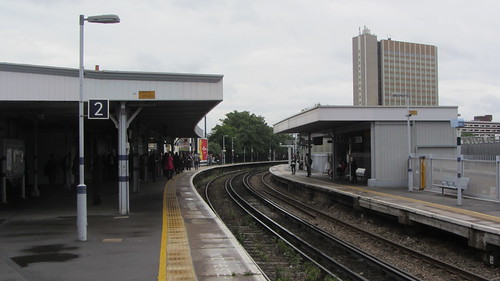In the last few blogs I've argued the case for Lewisham Junction, the development of a major new rail interchange for South East London, backed by regeneration of Lewisham. This blog looks at how the DLR interacts with the site.
Lewisham Junction and the DLR
The Lewisham Junction proposal faces an immediate peoblem in that it acts as less of a junction than the current Lewisham (North) station. This is expected and is the trade off between the inability to further expand the existing site and building a new junction from scratch.
Key to making the new junction work is the DLR.
The first DLR extension would need to be from Lewisham (North) to Lewisham Junction. This would almost certainly be in addition to the existing railway line that runs to Hayes. This extension would be essential to the viability of the station as a junction, especially for connections to Canary Wharf and Stratford.
There has also been talk of extending the DLR, to Catford separate to this proposal. Having been to Ladywell, I'm uncertain as to how that would happen without closing the Hayes line north of Catford. Now this may be a longer term option, but doesn't seem likely now.
Instead, I want to focus on a different DLR extension - from Woolwich. It isn't always appreciated that the DLR station in Woolwich faces west, rather than south. As such, the most logical direction for extension is to the west.
DLR from Woolwich to Lewisham Junction
This proposal would extend the DLR from Woolwich to the new Lewisham Junction station. There would seem to be two main approaches.
The first approach (in purple/red) would see a new tunnel of 2.2 miles from Woolwich to Charlton, probably via the B210 Artillery Place/Hillreach. From there, it would take over the Charlton to Blackheath line from Network Rail, potentially adding a new station by opening up the tunnel near Old Dover Road. From Blackheath to Lewisham Junction, the DLR would then run on the surface alongside or above the existing line to Lewisham before turning to Lewisham Junction. This last section could also be tunnelled.
The second approach (in green) is to tunnel the whole way, running via Blackheath, but not via Charlton. This approach would allow new areas to be served that are currently remote from rail public transport. The amount of tunnelling is of the order of 4.5 miles. Note that the tunnel length is only twice that of the first approach.
The two routes are shown here:
The key benefits of these two DLR extensions is a major boost to public transport connectivity in the area. Lewisham Junction would have direct services to both Canary Wharf and City airport, as well as boosting regeneration in Woolwich.
Summary
The Lewisham Junction proposal cannot work without extending the Lewisham DLR branch to the site. However, the site really starts to work if the Woolwich DLR line is extended to Lewisham Junction as well.










